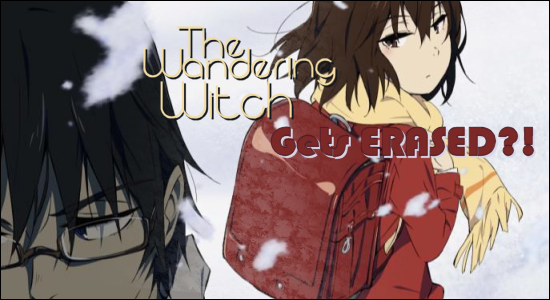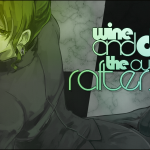The Wandering Witch – Gets ERASED?!

Welcome, all, again. This is proving to be a glorious viewing season, with offerings for fans of all genres. I absolutely love KONOSUBA-God’s blessing on this wonderful world!, a comedy/fantasy wherein a newly deceased youth coerces the goddess juggling his soul to accompany him to a world seeking heroes; likewise Ooya-san wa Shishunki!, a comedy short about a middle school landlady and her tenants. Tabi Machi Late Show, discussed previously, has already ended after just four episodes but remains available for viewing. I once heard a Japanese phrase that was roughly translated as: “the beauty of the sadness of being human,” and such is the perfect description of this introspective show. I’ve even found sports and mecha series that I’m enjoying, those being AOKANA: Four Rhythm Across the Blue and Active Raid, respectively. But this column focuses upon a series that I quite honestly did not want to watch–one from which I cringe–but am still by some calamity compelled to follow: ERASED.
Long ago, before cinema became so reliant upon blood and gore and shock, there existed a genre of film called the psychological thriller. ERASED has admirably recaptured much of that genre’s emotional tension and induced mental fatigue; indeed, I think that Alfred Hitchcock himself might have appreciated the treatment given this show’s tone and plot. Our protagonist, Satoru Fujinuma, is a bachelor on the cusp of thirty who lives alone and works delivering pizza. He has come to possess an ability, which he calls Revival, to travel back in time by approximately five minutes in order to try to redirect fate. The catch is that he must recognize what needs changing; that, and the small fact that the issues in question will usually prove to be life-or-death for the people involved. No pressure, right? But while most people might shy away from the implied responsibilities of such an ability, Satoru instead feels an obligation, haunted as he is by a tragedy which he was unable to prevent–the kidnapping(?) and murder of a childhood classmate, 10-year-old Kayo Hinazuki. It is this guilt that drives Satoru and his story.
Before I proceed, an aside. . .As a police officer, I would caution that I found the portrayals of a child suffering physical abuse–and the implied possibility of her suffering sexual predation as well–to be heartbreakingly realistic. Such is Kayo’s life, and the fear, resignation, and shame that she exhibits are behaviors which I have seen in actual victims of these crimes. (If you ever want to feel truly, completely powerless, try to comfort a child who has never felt safe in his/her own home.) More than once I had to walk away from episode 3, and I haven’t suffered such a strong visceral reaction to portrayals of abuse since watching Myself; Yourself. Maybe the medium of animation makes these things easier for some people to view, but I’ve nonetheless found this series unsettling and unnerving. (Perhaps why I felt compelled to review it?)
But back to our story. Satoru’s ability enables him to save a child from being struck by a runaway truck, but in so doing he is injured and hospitalized, prompting the arrival of his mother. Her visit is in turn cut short by her brutal murder in Satoru’s apartment while he is out, which fact does nothing to prevent him from becoming the prime suspect. Satoru flees the police, only to experience a Revival event that transports him back 18 years, to just before his classmate’s disappearance. Now, what to do? His is an adult mind trapped inside a child’s body, burdened by the certain knowledge that a horrific crime is about to take place–and also the realization that, because this Revival event was triggered by his mother’s future murder, the key to preventing that murder is only available to his childhood self. But what can a child do with such knowledge? And how can he influence fate when his age limits his influence even upon those closest to him? How many lives can his small hands save?
There is a disconcerting realism to many aspects of this show, almost to the point of allowing viewers to forget or ignore the fantasy of time travel: patterns of abuse exhibited by both parent and child; the reactive nature of police work limiting their available response options and involvement; the frustration of friends and teachers who witness the glacial slowness of Child Protective Services bureaucracy. . .ERASED highlights the actions of engaged individuals against the deliberate indifference of society, even while acknowledging that not all such individuals have good intentions. This is inspired writing[!] delivering a sobering message, while the artwork is muted and frequently dark to match the series’ mood, as is the music. ERASED is deservedly an “instant classic,” one you won’t want to miss.



![1b5ebe2a3ef25e4fe23d0861cd908c511451466235_full[1]](http://918thefan.com/wp-content/uploads/2016/02/1b5ebe2a3ef25e4fe23d0861cd908c511451466235_full1-300x169.png)
![gYSlaAn[1]](http://918thefan.com/wp-content/uploads/2016/02/gYSlaAn1-300x169.png)
![boku2[1]](http://918thefan.com/wp-content/uploads/2016/02/boku21-300x158.jpg)













Awesome Blog Moonhawk81!!! I like ERASED so far!!! I’m going to watch the rest of the anime series on Crunchyroll!
ERASED has become a must-watch! I hate that my review went up so late in the season–it was prepared for February, but some computer-type problems beyond my poor understanding prevented it from being posted then. Still, it’s a compelling series and I’m grateful to have reviewed it.